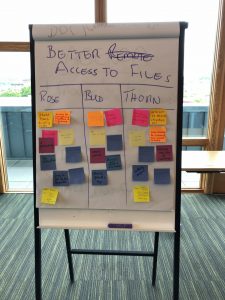I met with a customer recently to review our recommendations for ways to align IT with the organization’s mission and work. As we wrapped up our work the customer asked that we present our findings to the staff. We thought this meeting would help with change management: how to get staff buy-in to the recommendations, especially the ones that likely involved the most staff impact. I thought putting design thinking to work for us might help do that.
Rather than perform a (dry) review of the dozens of recommendations we had made, I chose to structure the session around some design thinking techniques that would build staff consensus and a shared vision of next steps.
Putting Design Thinking to Work
I took the opportunity to use some materials I had seen from the Luma Institute, thanks to last year’s TAG Conference. Luma Institute has curated “design thinking” approaches from all kinds of sources and makes them available in a format that enables you to quickly understand them and put them to use.
For our session, I chose two “plays” intended to help get everyone on the same page. The first was “Rose-Bud-Thorn.” The second was an “Importance/Difficulty” matrix.
Rose-Bud-Thorn
In Rose-Bud-Thorn, we presented the top three recommendations and asked staff to complete at least one “Rose” (“what could go right?”). Next, we wanted staff to complete at least one “Bud” (“what unexpected positive outcome might occur?”). Finally, we asked staff to complete at least one “Thorn” (“what could go wrong?”) for each recommendation. I was interested in gauging staff perceptions on what might be positive about adopting a collaboration tool. I was also interested in knowing what staff thought could go wrong. This would give me an idea of what to watch for in a forthcoming implementation. As you can see from the picture, staff were not shy about sharing their thoughts! (Starting the session with shared chocolates may have helped here.)

Each staff member had a chance to share their input. Afterward, I summarized each type of input, and focused on testing for what kind of action might be needed to address or prevent the “thorns” that the group had highlighted.
Importance/Difficulty Matrix
Following this activity, we turned to discussing the relative timing for implementation of the top three projects. I had staff start by placing each project along an importance scale, from very low (for the organization) to very high. Of course, I wasn’t surprised that most staff felt all three projects fell in the “very high” end of the range. Some staff jumped ahead to the Difficulty ranking, noting that it would be important to balance what could be done sooner vs. later, along with relative impact of each project. So, I then had staff rate each project according to a perceived level of difficulty to implement.
This should have resulted in every MBA’s favorite, a 2×2 quadrant chart. As it turned out, forcing everyone to rank the projects that way wasn’t getting me any additional valuable input, so I left things as you see in the picture below.

We had identified some implementation considerations for each recommendation. The group also had an idea—although not definitive—about the order of implementation. We were then able to focus our discussion on how we could move each recommendation forward. It became clear that we really had to consider all three recommendations together. So, our discussion centered on how we could incrementally move each item forward, given staff availability over the coming months and given external factors that drove some needs to the fore.
Try Putting Design Thinking to Work for Your Next Decision
If you haven’t worked with design thinking tools before, I recommend you give them a try. It’s easy to get to a point where, as a team, you feel like you’re not making progress on a decision or heading down the same blind alleys over and over. Design thinking gives you some easy-to-use tools that can help you clear those obstacles and get to a better outcome. Plus, you get to play with sticky notes and scented markers, so there’s that.





0 Comments